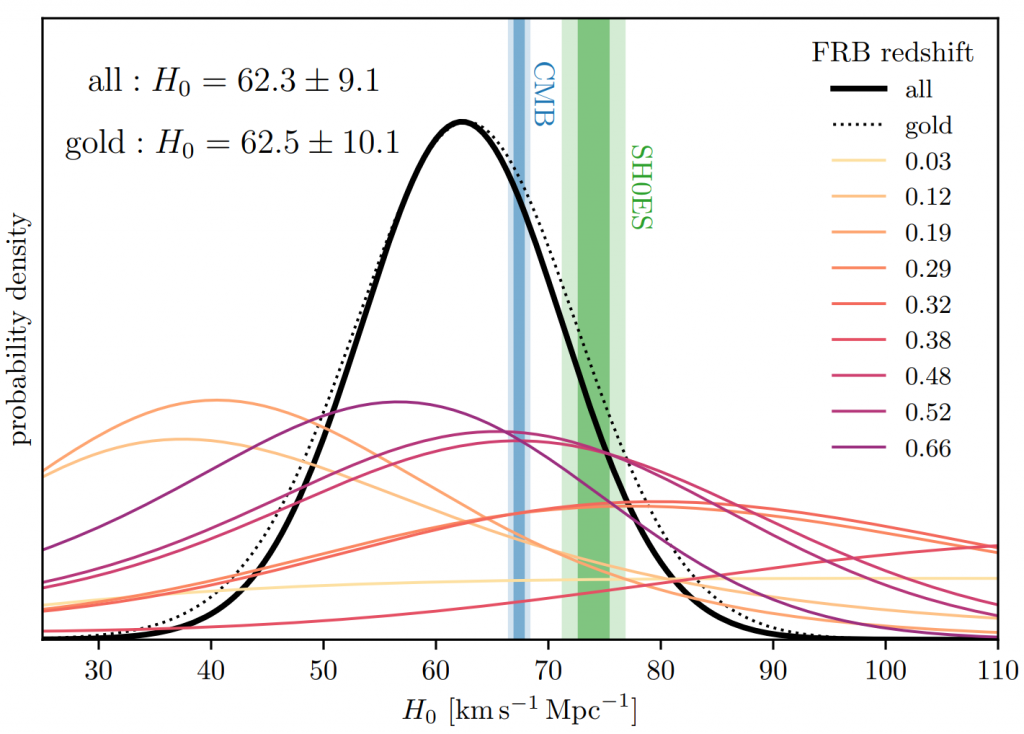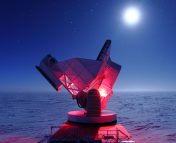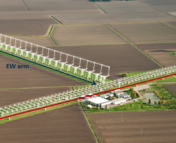Title: “A new measurement of the Hubble constant using Fast Radio Bursts”
Authors: Steffen Hagstotz, Robert Reischke, Robert Lilow
First Author’s Institution: The Oskar Klein Centre for Cosmoparticle Physics, Department of Physics, Stockholm University, Roslagstullsbacken 21A, SE-106 91 Stockholm, Sweden
Status: Submitted to MNRAS [open access on arXiv]
The Tension Builds
Cosmology is in crisis: the present-day value of the Hubble constant (H0) — the current expansion rate of the Universe — as inferred by studying the cosmic microwave background (CMB) is incompatible with the value inferred by studying distant supernovae. Since the Hubble constant calibrates the age of the Universe and the entire history of the Universe’s expansion, the lack of consensus on a definitive value for H0 is a dire problem — perhaps the biggest problem in modern astronomy! Despite this “Hubble tension” growing over the past several years, no convincing theoretical explanation for the problem has been proposed. So far, measurements of H0 using techniques independent of the CMB and supernova results (for instance, distance calibration based on the tip of the red giant branch, strongly lensed quasars, MASER emission, or the “standard sirens” of compact object mergers) have only marginally agreed with one or the other side of the Hubble conflict — we still lack conclusive independent evidence favoring either of the two primary opposing results. However, the authors of today’s paper propose that fast radio bursts (FRBs) could provide such evidence.
Tuning into Extragalactic Radio Broadcasts
Fast radio bursts are extremely energetic, short pulses of radio waves lasting a matter of milliseconds. While the CHIME collaboration may have confirmed that magnetars are a source of FRBs, this does not rule out other possible sources; the fact that we’ve observed some FRBs that repeat periodically, some that repeat in irregular patterns, and some that don’t repeat at all may point to a number of different classes of FRB progenitors. Regardless, we have strong evidence that these FRB sources are distributed isotropically on the sky and range in distance from within our own Milky Way to deep into extragalactic space; this seeming ubiquity of FRB signals makes them ideal cosmological probes, providing us a window into the far reaches of the Universe (see, for example, how FRBs have been used to constrain the diffuse gas fraction in the intergalactic medium). In fact, all we need in order to leverage the cosmological power of an FRB is its location in space, its direction in the sky, and a quantity called the dispersion measure, which is the key component linking an FRB to the Hubble constant.
As a radio wave travels through intergalactic space, it interacts with free electrons, slowing down with each electron interaction; the number of electrons with which the radio wave interacts as it travels from source to observer is quantified by the dispersion measure (DM for short, not to be confused with “dark matter” or “direct message”). Lower radio frequencies are slowed down by free electrons to a greater degree than are higher frequencies; therefore, one can infer the dispersion measure by observing the time delay between different frequency components of a radio pulse. A cartoonish visualization of this frequency-dependent dispersion is shown in Figure 1.

The authors note that the DM associated with an FRB pulse can be split into three components: one due to electrons in the Milky Way, one due to electrons in the halo of the FRB’s host galaxy, and one due to electrons in the large-scale structure (LSS) of the intergalactic medium (IGM). The DM due to the Milky Way can be computed with relatively high accuracy based on models of the Galactic electron distribution. On the other hand, the DM due to the FRB host bears significant uncertainty because of limitations on the observability of distant FRB hosts. Although this observational limit is the main source of uncertainty in this study, it is the DM due to the LSS that holds the most crucial information: the large-scale structure’s sensitivity to the conditions of the IGM and to the expansion of the Universe lends the DM a direct dependence on redshift, cosmic baryon density, and H0.
From Dispersion Measure to Cosmological Treasure
While a total of 118 transient radio signals have been confirmed to be FRBs, only nine of these have an identified host galaxy and associated redshift estimate; the authors thus take these nine FRBs to be their data set. For each FRB, they measure the total DM, then subtract out the estimated contributions from the Milky Way and the host halo, leaving only the cosmologically important contribution from the LSS. The authors then construct one-dimensional probability density functions (PDFs) parameterized by the Hubble constant for each of the FRBs, reflecting their respective likelihoods and uncertainties; combining these nine PDFs yields a joint distribution peaked at H0 = 62.3 ± 9.1 km s-1 Mpc-1, a value 5.1 km s-1 Mpc-1 below the mean of the most recent CMB constraints and 11.7 km s-1 Mpc-1 below the most recent supernova constraints. The authors repeat the analysis with the three most uncertain DMs discarded, finding a new joint PDF peaked at H0 = 62.5 ± 10.1 km s-1 Mpc-1. These results are shown in Figure 2.

To conclude the paper, the authors estimate the number of FRB data points necessary to constrain H0 to percent precision; at this precision, the FRB H0 value could serve as a definitive independent arbitrator between the CMB and supernova H0 results. The authors find that only a few hundreds of FRBs are required to sufficiently constrain the relationship between DM and redshift and the large uncertainties in the host galaxy DMs. With such recent instruments as CHIME, HIRAX, and ASKAP expected to detect dozens of events each night — and the future Square Kilometer Array promising to discover up to thousands of FRBs each night — the future of FRB cosmology is looking brighter than the fast radio bursts themselves!
Astrobite edited by Wei Vivyan Yan
Featured image credit: New Scientist




